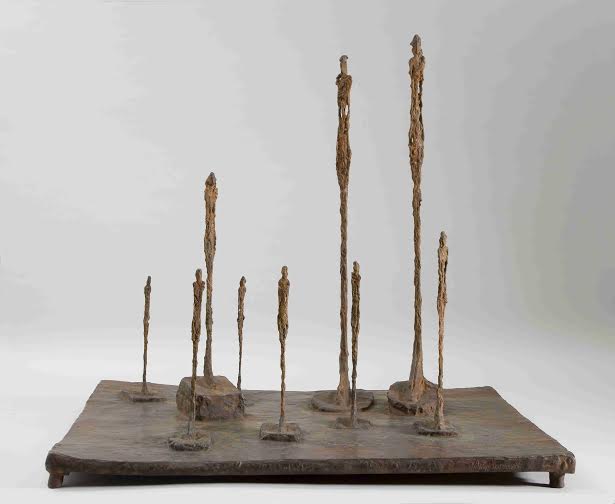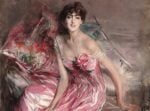Alberto Giacometti

La mostra propone l’intero percorso artistico di uno dei più significativi scultori del Novecento con capolavori assoluti quali Boule suspendue, Femme qui marche, La cage, Quatre femmes sur socle, Buste d’Annette o ancora la monumentale Grande femme.
Comunicato stampa
Alberto Giacometti, uno dei più significativi scultori del Novecento, in mostra dall’8 ottobre 2014 al 1 febbraio 2015 alla GAM – Galleria d’Arte Moderna di Milano con capolavori assoluti quali Boule suspendue, Femme qui marche, La cage, Quatre femmes sur socle, Buste d’Annette o ancora la monumentale Grande femme.
Il visitatore potrà seguire, attraverso le sculture, i dipinti e i disegni realizzati tra gli anni Venti e Sessanta, l’evoluzione artistica di Giacometti, dai suoi inizi in Svizzera alla maturità, trascorsa perlopiù nell’atelier di rue Hippolyte-Maindron a Parigi: un percorso cronologico che si articola in cinque sezioni, costituite a loro volta da diversi gruppi tematici, e che permette di ripercorrere la carriera dell’artista: dall’esordio a contatto con il Post-cubismo e il Surrealismo, all’età più avanzata, durante la quale il filo conduttore diventa la perpetua ricerca di qualcosa che gli sfugge.
A corredo e integrazione del percorso una selezione di disegni e schizzi, immagini d’archivio, foto intime e d’autore, che aiuteranno il visitatore a meglio contestualizzare il procedimento artistico di Giacometti, dal periodo Surrealista agli ultimi anni.
La mostra fa parte di “Milano Cuore d’Europa”, il palinsesto culturale multidisciplinare dedicato all’identità europea della nostra città anche attraverso le figure e i movimenti che, con la propria storia e la propria produzione artistica, hanno contribuito a costruirne la cittadinanza europea e la dimensione culturale.
The ‘Alberto Giacometti’ exhibition opening on 8 October 2014 at the Galleria d’Arte Moderna (GAM) in Milan covers the entire artistic trajectory of one of the most important sculptors of the 20th century. The show features absolute masterpieces like La Boule suspendue, Femme qui marche, La cage, Quatre femmes sur socle, Buste d’Annette and the monumental Grande femme IV.
Curated by Catherine Grenier, chief curator and director and of the Fondation Alberto et Annette Giacometti in Paris, which is providing 60 works from its collect. The show is promoted by the Milan City Council – Culture and produced by the Galleria d’Arte Moderna, Milan, and 24 ORE Cultura – Gruppo 24 ORE. It is the first of four major sculpture exhibitions that will be staged by the recently refurbished GAM.
Sculptures, paintings and drawings executed between the 1920s and 1960s will enable the visitor to follow Giacometti’s artistic development, from his beginnings in Switzerland to his mature period, spent mostly at the studio in rue Hippolyte-Maindron, Paris. The works are arranged chronologically and divided into five sections, each based on different themes. This will make it possible to follow the artist’s entire career, from his debut influenced by Post-Cubism and Surrealism to his late period marked by a constant quest for a truth that eluded him.
The exhibition will be accompanied and completed by a selection of drawings and sketches, archive images, personal and masterpieces of great photographers, which will help the visitor to contextualize Giacometti’s artistic process from the Surrealist period to his last years.
The sections of the exhibition
The first section will introduce the visitor to Giacometti’s private world through sculpture portraits of his father, his mother Annetta, his brother Diego and sister Ottilia, and then to the works he made in Paris – where he moved on his father’s advice – after 1922, which were the product of the Cubist climate in the city during that period.
In 1931 Giacometti adhered to Surrealism, to which he had been introduced by Cocteau, Masson and the Noailles. The second section features works created during this intense period (he drifted away from the movement in 1935): real masterpieces, such as La Femme qui marche, conceived as a mannequin for the Surrealist Exhibition in 1933; Le Couple, which clearly reveals his interest in African art, and the still more famous La Boule Suspendue, described by Dalì as the prototype of “objects with a symbolic function” – a key issue in Surrealist thought.
The third section attests to the innovative research Giacometti conducted by working from life: the portraits were made on a reduced scale – they were only a dozen centimetres high – and the head soon became his main focus. On display are the two versions of Tête de femme, from 1935 and 1938, which prefigure the painted and sculpted heads from the 1950s and 1960s.
This section also documents the period when Giacometti began working again after the war, upon his return to Paris in 1945. It was then that he started to create his stringy effigies, hieratic, motionless figures rigidly arranged on thick bases or inside cages that determine their spatial limits. These are represented in the show by Quatre femmes sur socle of 1950, La Clairière and La Cage of the same year.
The fourth section illustrates the artist’s research on the rendition of the head, anticipated in the portraits of Rita and Diego, and well evident in the paintings and sculptures of Giacometti’s maturity. He chose as models the people closest to him, such as his wife Annette (Buste d’Annette, 1962), his brother Diego (Buste de Diego, 1964), the Japanese philosopher Yanaihara (Buste de Yanaihara, 1961), and his mistress Caroline. Both in painting and in sculpture Giacometti worked intensely in his ceaseless quest for the truth of the model.
The fifth section features the artist’s late works, bringing the exhibition to a close. In 1958 Alberto Giacometti worked in the creation of the monumental sculptures Grande tête (1960–1966) and Grande femme IV (1960–1961), whose rugged surface heightens their dramatic quality. They are the largest ever executed by the artist. In the exhibition these sculptures are juxtaposed with two portraits of a man and woman with their arms resting on their thighs in the manner of ancient sculptures. The four pieces share an intense gaze, directed straight ahead and lost in an almost prophetic beyond.



